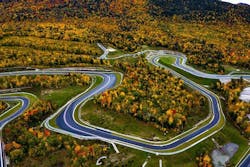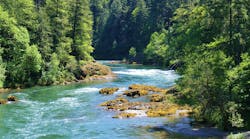About the author:
Mike Everhart is erosion control and geo-product specialist for EJ Prescott. He can be reached at [email protected].
In 2013, Club Motorsports began construction of a private race track at the southern edge of the New Hampshire White Mountains. They designed the track with the idea in mind of a 'country club' for car enthusiasts. The design featured a 2.5-mile road course on more than 100 wooded acres and boasted breathtaking views of the mountain range to the north. The beauty in the design was only outweighed by the impossible landscape it would cover. It would take over four years, blasting nearly 200,000 cubic yards of ledge and moving over a million cubic yards of material to complete.
The challenge of this project was incorporating 250 feet of elevation change into 15 individual track turns. The design of each turn was to have its own unique beauty, which added to the complexity of the project. Racing curbs flowed into grassed shoulders and large grassed drainage swales. The grass swales, along with the major elevation difference, and an average track width of 50 feet, would mean a simple rain event would cause a tremendous amount of watershed. The storm water runoff would devastate the site, but the unique elevation change and aesthetics of the grass shoulders all added to the lure and mystique of the track. It was clear that creative erosion control was going to be the answer.
One of the first things needed for this project was to establish sustainable vegetation. The first method used was to install rolled erosion control blanket (RECB) on the slopes around the track. This process was a great solution in the majority of the sections. Before beginning installation, the seed was applied. Next, a small trench was dug at the top of the slope to create a 'keyway' for the blanket. One thing to note is the importance of always stapling and burying the RECB in the keyway. This prevents storm water from flowing under the blanket from the top of the slope. Once the RECB was secured at the top of slope, it was rolled down and stretched tight to ensure good ground contact, overlapping the sides of the blanket. If there are any void spaces, it will give water an opportunity to pick up speed and take material with it. At this point, the appropriate amount of staples were applied in a specific pattern. This process continued until all the slopes were covered. The few sections that did not take well suffered undermining of the blanket. This was likely caused by ground obstructions such as roots, rocks or twigs. These objects can create void space under the blanket.
The project team applied hydraulic erosion control mulches (HECP) through a method known as hydroseeding. Any mulch, seed, fertilizer and water needed were added to the tank of the hydroseeder. The mixture was emulsified then sprayed on the area that required vegetation. The process is like spraying on a liquid blanket to both the flat areas and the slopes. Unlike RECB, the hydroseeding process will provide full coverage, regardless of ground obstructions. For the flat areas and smaller slopes, the team used a simple base mulch of 70/30 wood to paper blend. On the steeper areas, they needed to use an erosion control much. In this application, they used both a bonded fiber matrix (BFM) and a flexible growth medium (FGM).
One of the design challenges mentioned earlier was the large grass drainage swales for storm water control. The original design called for a rock riprap in the drainage ways, a common application throughout New England. It was suggested to use grass in the swales to be more aesthetically pleasing and environmentally friendly. The recommendation was to use a turf reinforcement mat (TRM) and then hydroseed it with the FGM. In contrast to a RECB that is designed to degrade over time, a TRM is a permanent erosion control blanket used in areas with a potential for high volumes of water. After some discussion, the project engineer created new details and integrated the grass swales in place of the rock riprap.
Once the project was underway, the team experienced rain events. The track was fully paved, and the topsoil was installed throughout the shoulders of the track. Erosion control methods had not yet been applied to the new topsoil, leaving them vulnerable to the weather. The heavy rains were sheeting over the 50 foot wide track on to unprotected topsoil. This volume of storm water runoff threatened to undermine the new pavement. To resolve the situation, compost filter socks and straw wattles were put in place along the edge of the pavement to slow the storm water velocity and minimize additional soil loss. Having the compost filter socks on the edge of the track was also a way to filter out sediments and hydrocarbons from the storm water passing over the new asphalt.
After the weather passed, the team began spaying the BFM and FGM on the track shoulders. Since the shoulders would require working with compacted soils, a new challenge arose. The shoulders had to be compacted so cars had the ability to skid off the track without creating large ruts, causing a safety issue for other cars. The challenge is that trying to establish vegetation in compacted soils is difficult. Soil tests were done to see what would be needed to build up the soil health. The team added quick-acting lyme, quick starting fertilizers and a slow-release organic fertilizer. Sections of the shoulder with concentrated storm water runoff were of concern. In those areas, the project team added a specific geocell cellular confinement system to structurally confine the topsoil and allow the vegetation to establish.
Lastly, the concrete racing curbs were installed and a slot-drain system placed strategically along the track in areas that see a lot of storm water runoff. In some areas where the racing curb was installed, either a rigid panel grass pave system or a geocell cellular confinement system was installed along the back side. These were used to allow for vegetation and the ability to support the weight of a run-away car.
The private race track was completed in 2017 and has been busy ever since.


